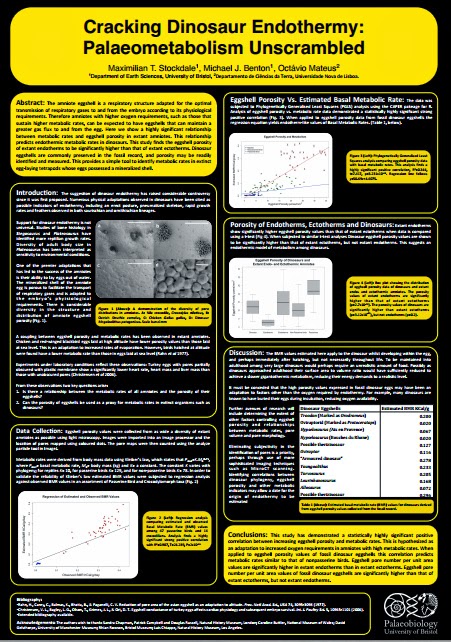O metabolismo e paleotemperatura corporal de animais extintos é um dos grandes mistérios na paleontologia. Fizeram-se muitas abordagem usando isótopos, histologia, anatomia comparada, etc. Numa nova abordagem mostra-se que o número, densidade e dimensão dos poros existentes nas cascas de ovos dos diferentes animais está correlacionado com o metabolismos.
No último congresso SVP foi apresentado um trabalho que mostrava exactamente isso. O trabalho foi assinado por Max Stockdale, Mike Benton e Octávio Mateus.
Abstract
The amniote eggshell functions as a respiratory structure adapted for the optimal transmission of respiratory gasses to and from the embryo according to its physiological requirements. Therefore amniotes with higher oxygen requirements, such as those that sustain higher metabolic rates, can be expected to have eggshells that can maintain a greater gas flux to and from the egg. Studies of extant amniotes have found that eggshells of reduced porosity impose a limit on the metabolic rate of the offspring. Here we show a highly significant relationship between metabolic rates and eggshell porosity in extant amniotes that predicts highly endothermic metabolic rates in dinosaurs. This study finds the eggshell porosity of extant endotherms to be significantly higher than that of extant ectotherms. Eggshell porosity values of dinosaurs are found to be significantly higher than that of extant ectotherms, but not extant endotherms. Dinosaur eggshells are commonly preserved in the fossil record, and porosity may be readily identified and measured. This provides a simple tool to identify metabolic rates in extinct egg-laying tetrapods whose eggs possessed a mineralized shell.
Stockdale, M., Benton M., & Mateus O. (2014). Cracking dinosaur endothermy: paleophysiology unscrambled. Journal of Vertebrate Paleontology. Program and Abstracts, 2014, 235-236. PDF





Sem comentários:
Enviar um comentário